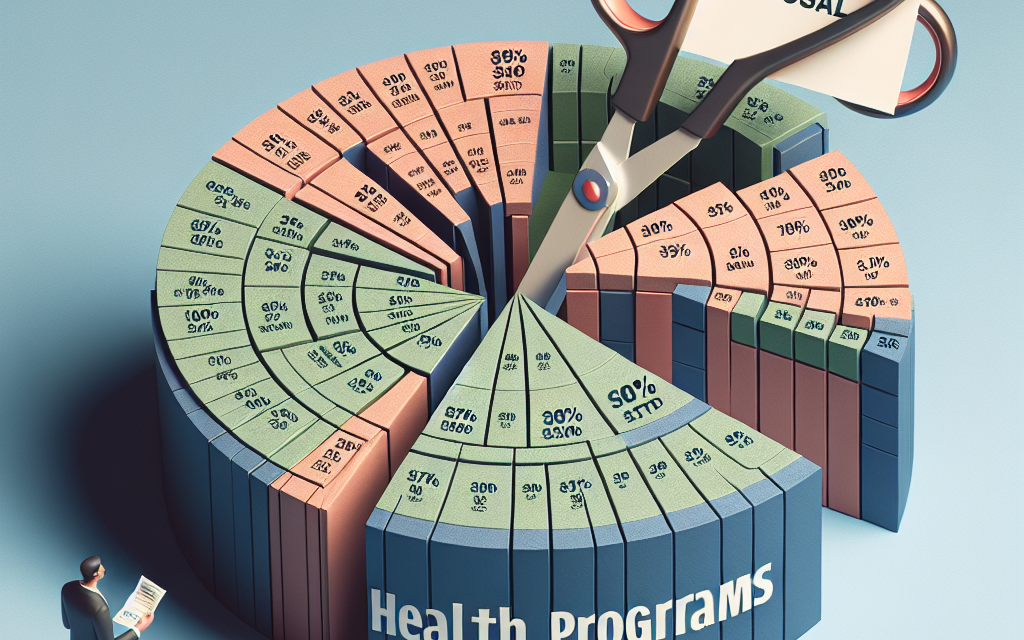Trump’s Budget Proposal Aims to Cut Federal Health Programs
In the realm of American politics, budget proposals often serve as a reflection of a government’s priorities and values. Former President Donald Trump’s budget proposal, particularly during his administration, aimed to significantly cut federal health programs, sparking intense debate and concern among various stakeholders. This article delves into the implications of these proposed cuts, examining their potential impact on public health, vulnerable populations, and the overall healthcare system in the United States.
Understanding Trump’s Budget Proposal
Trump’s budget proposal, particularly in the context of health programs, was characterized by a focus on reducing federal spending. The administration sought to cut funding for several key health initiatives, including Medicaid, the Affordable Care Act (ACA), and various public health programs. The rationale behind these cuts was often framed in terms of fiscal responsibility and the need to reduce the national deficit.
However, the implications of these cuts were far-reaching, affecting millions of Americans who rely on federal health programs for their well-being. The proposal raised questions about the balance between fiscal conservatism and the moral obligation to provide healthcare to those in need.
1. The Impact on Medicaid
Medicaid, a vital program that provides health coverage to low-income individuals and families, was one of the primary targets of Trump’s budget cuts. The proposed reductions aimed to limit federal funding for Medicaid expansion, which had been a significant component of the ACA.
According to the Kaiser Family Foundation, Medicaid covers over 70 million Americans, including children, pregnant women, elderly individuals, and people with disabilities. The proposed cuts would have profound implications for these vulnerable populations.
- Reduction in Coverage: The budget proposal sought to implement work requirements and other restrictions that could lead to millions losing their coverage. States that expanded Medicaid under the ACA would face significant financial challenges, potentially leading to cuts in services or eligibility.
- Impact on Health Outcomes: Studies have shown that Medicaid expansion is associated with improved health outcomes, including increased access to preventive care and reduced mortality rates. Cutting funding could reverse these gains, leading to worse health outcomes for millions.
- State Budgets at Risk: States that rely heavily on federal funding for Medicaid would face budget shortfalls, forcing them to make difficult decisions about healthcare services. This could lead to increased costs for hospitals and providers, ultimately affecting patient care.
For example, a study conducted by the Urban Institute found that states that expanded Medicaid saw a 7% decrease in uninsured rates among low-income adults. Conversely, states that did not expand Medicaid experienced higher rates of uninsured individuals, leading to increased emergency room visits and higher healthcare costs overall.
2. The Affordable Care Act and Its Vulnerabilities
The Affordable Care Act (ACA), often referred to as Obamacare, was another focal point of Trump’s budget proposal. The administration aimed to dismantle key provisions of the ACA, including subsidies for low-income individuals purchasing insurance through the marketplace.
The ACA has played a crucial role in expanding access to healthcare for millions of Americans. According to the U.S. Department of Health and Human Services, the ACA has led to a significant decrease in the uninsured rate, particularly among low-income populations.
- Subsidy Cuts: The proposed budget cuts aimed to eliminate subsidies that help low-income individuals afford health insurance. This would have made healthcare unaffordable for many, leading to increased rates of uninsured individuals.
- Market Instability: Reducing funding for the ACA could destabilize insurance markets, leading to higher premiums and fewer choices for consumers. Insurers may exit the market, further limiting access to care.
- Public Health Consequences: A rise in uninsured individuals could lead to increased reliance on emergency services, which are often more costly and less effective than preventive care. This could strain public health systems and lead to worse health outcomes.
For instance, a report from the Congressional Budget Office estimated that repealing the ACA would result in 32 million Americans losing their health insurance by 2026. This stark statistic underscores the potential consequences of cutting funding for the ACA and the ripple effects it could have on public health.
3. Cuts to Public Health Programs
In addition to targeting Medicaid and the ACA, Trump’s budget proposal also aimed to cut funding for various public health programs. These programs are essential for disease prevention, health promotion, and emergency preparedness.
Public health initiatives, such as vaccination programs, maternal and child health services, and disease surveillance, play a critical role in maintaining the health of communities. The proposed cuts raised concerns about the ability of public health agencies to respond effectively to health crises.
- Vaccination Programs: Cuts to funding for vaccination programs could lead to decreased immunization rates, increasing the risk of outbreaks of vaccine-preventable diseases. This is particularly concerning in light of recent measles outbreaks in the U.S.
- Maternal and Child Health Services: Reductions in funding for maternal and child health programs could jeopardize access to essential services for pregnant women and children, leading to adverse health outcomes.
- Emergency Preparedness: Public health agencies rely on federal funding to prepare for and respond to health emergencies, such as pandemics or natural disasters. Cuts to these programs could hinder the nation’s ability to respond effectively to future crises.
For example, during the COVID-19 pandemic, public health agencies faced unprecedented challenges. Funding cuts prior to the pandemic had already weakened the infrastructure necessary for effective disease surveillance and response. The consequences of these cuts became evident as the nation struggled to contain the virus’s spread.
4. The Economic Implications of Health Program Cuts
The proposed cuts to federal health programs not only have direct implications for individuals’ health but also significant economic consequences. The healthcare sector is a major driver of the U.S. economy, and cuts to health programs could have far-reaching effects.
Healthcare spending accounts for nearly 18% of the U.S. GDP, making it a critical component of the economy. Reducing funding for health programs could lead to job losses, decreased economic activity, and increased costs for individuals and families.
- Job Losses in Healthcare: Cuts to Medicaid and other health programs could lead to job losses in the healthcare sector. Hospitals and clinics may be forced to reduce staff or close services, impacting employment in local communities.
- Increased Healthcare Costs: As access to preventive care decreases, individuals may face higher healthcare costs due to increased reliance on emergency services. This could lead to financial strain for families and increased bankruptcies related to medical debt.
- Impact on Local Economies: Healthcare facilities are often significant employers in their communities. Reductions in funding could lead to decreased economic activity, affecting local businesses and services.
A study by the American Hospital Association found that hospitals provide nearly $41 billion in community benefits annually, including charity care and services for vulnerable populations. Cuts to federal health programs could jeopardize these contributions, further exacerbating economic disparities in communities.
5. Public Response and Political Ramifications
The proposed cuts to federal health programs elicited strong reactions from various stakeholders, including healthcare providers, advocacy groups, and the general public. The political ramifications of these proposals were significant, influencing public opinion and electoral outcomes.
Advocacy groups mobilized to oppose the cuts, emphasizing the potential harm to vulnerable populations and the importance of maintaining access to healthcare. Public protests, campaigns, and lobbying efforts aimed to raise awareness about the consequences of the proposed budget cuts.
- Grassroots Movements: Organizations such as the American Medical Association and the National Association of Community Health Centers rallied against the proposed cuts, highlighting the potential impact on patient care and public health.
- Electoral Consequences: The proposed cuts became a focal point in elections, with candidates using healthcare as a key issue to mobilize voters. Many Democrats campaigned on protecting and expanding access to healthcare, while Republicans faced backlash for supporting cuts.
- Public Opinion: Polls indicated that a majority of Americans opposed cuts to Medicaid and other health programs. This public sentiment influenced political discourse and shaped the priorities of lawmakers.
For instance, during the 2018 midterm elections, healthcare emerged as a top issue for voters, contributing to significant Democratic gains in the House of Representatives. The backlash against proposed cuts underscored the importance of healthcare as a political issue and its impact on electoral outcomes.
Conclusion
Trump’s budget proposal aimed at cutting federal health programs raised significant concerns about the future of healthcare in the United States. The proposed reductions to Medicaid, the Affordable Care Act, and public health initiatives threatened to undermine access to care for millions of Americans, particularly vulnerable populations.
The economic implications of these cuts were equally concerning, with potential job losses in the healthcare sector and increased costs for individuals and families. Public response to the proposed cuts highlighted the importance of healthcare as a political issue, influencing electoral outcomes and shaping public discourse.
As the nation continues to grapple with healthcare challenges, the lessons learned from Trump’s budget proposal serve as a reminder of the delicate balance between fiscal responsibility and the moral obligation to provide healthcare for all. The future of federal health programs remains a critical issue that will shape the landscape of American healthcare for years to come.





